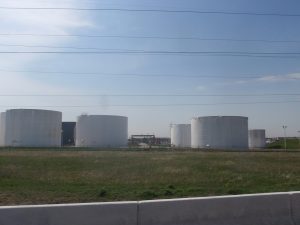5.3 Warehousing
Learning Objective
2. Offer insights on how warehouses help in storage and role of technology in it.
Warehouse
Figure 5.3
Warehouse
 Note. Shallow focus photo of gray steel muscle rack photo. From Unsplash. Reused under Unsplash Licence.
Note. Shallow focus photo of gray steel muscle rack photo. From Unsplash. Reused under Unsplash Licence.
A warehouse is one of the most important parts of a company with distribution functions, on which the entire company’s sustainability largely depends. It has a significant impact on economic and social sustainability as a part of the company that most absorbs the consequences of changes in demand. This has been best demonstrated nowadays, where there are large differences in demand (Popovic et . al., 2021 ). Though warehousing requires additional expenses in terms of labor, capital (land and storage-and-handling equipment) and information systems, we need them because they provide valuable services essential for businesses to operate in the current economic situation.
To learn more about the importance of warehouses with examples, please read Section 1.1: Why Have a Warehouse in Warehouse and Distribution Science by John J. Bartholdi and Steven T. Hackman.
Figure 5.4
More Oil Storage
 Note. More Oil Storage. From Flickr. CC BY 2.0.
Note. More Oil Storage. From Flickr. CC BY 2.0.
You might not know where the tiny town of Cushing, Oklahoma, is, but oil producers and traders around the world do. Cushing is one of the largest oil storage areas in the United States. Storage tanks like these cover more than nine square miles on the outskirts of the town (Davis, 2009).
In some cases, warehouses are also called Distribution Centers (DC). The major difference between these two is that former store products to be used by manufacturers, importers, exporters, wholesalers, transport businesses etc., later is a warehouse or storage facility where the emphasis is on processing and moving goods on to wholesalers, retailers, or consumers. A few years ago, companies moved towards large, centralized warehouses to keep costs down. For example, in 2005, Walmart opened a four-million-square-foot distribution center in Texas. (Four million square feet is about the size of eighteen football fields.) (University of Minnesota, 2015).
Today, however, the trend has shifted back to smaller warehouses. Using smaller warehouses is a change driven by customer considerations rather than costs. Warehousing products regionally, closer to consumers, can also help a company tailor its product selection better to match customers’ needs in different regions. Ultimately, a company selects their warehousing needs depending upon its consumers.
Did You Know?
Goya Foods has many challenges due to the variety of customers it serves. The company sells more than 1,600 canned food products. Because the types of beans people prefer often depend on their cultures — whether they are of Cuban, Mexican, or Puerto Rican descent, and so forth — Goya sells thirty-eight varieties of beans alone. Goya’s truck drivers deliver products daily to tens of thousands of U.S. food stores, from supermarket chains in Texas to independent mom – and – pop bodegas in New York City. Delivering daily is more costly than dropping off jumbo shipments once a week and letting stores warehouse goods, says the company’s CEO Peter Unanue. However, it’s more of a just-in-time method that lets Goya offer stores a greater variety and ensure that products match each store’s demographics. “Pink beans might sell in New York City but not sell as well in Texas or California,” says Unanue (De Lollis, 2009).
Functioning of Warehouses and Distribution Centers
A question may arise – How do warehouse associates find a product or pallet of products in a warehouse or distribution center the size of eighteen football fields? To begin with, each product is given its identification number, SKU (stock-keeping unit). Then, when the product enters the warehouse, it is scanned and given an “address,” or location, in the warehouse where it is stored until it is plucked from its shelf and shipped.
Figure 5.5
An Example of a SKU
Note. Scanning. From Flickr. CC BY-NC-SA 2.0
Warehouses and distribution centres are also becoming increasingly automated and wired. For example, some warehouses use robots to pick products from shelves. At other warehouses, employees use voice-enabled headsets to select products. Via the headsets, the workers communicate with a computer that tells them where to go and what to grab off shelves. As a result, the employees can pick products more accurately than at a sheet of paper or computer screen.
Video: Fulfillment by Amazon (2:02)
Amazon.com’s mission is “to be Earth’s most customer-centric company where people can find and discover anything they want to buy online.” Watch the following video to see one of Amazon’s order-fulfillment centers in action.
Media 5.3. Fulfillment by Amazon [Video]. Jon Norris. (URL: https://youtu.be/Qt9hkZmbNfU)
It is amazing when you think about how the thousands of products that come in and out of Amazon’s distribution centres every day ultimately end up in the right customer’s hands. After all, how many times have you had to look hard to find something you put in your closet or garage? The concept of Order Fulfillment helps here. Processing orders — order fulfillment — is a crucial part of the job in supply chains. Why? Because delivering what was promised, when it was promised, and how it was pledged are key drivers of customer satisfaction (Thirumalai & Sinha, 2005 ).
One of the ways companies are improving their order fulfillment and other supply chain processes is by getting rid of paper systems and snail – mail. So, for instance, instead of companies receiving paper orders and sending paper invoices to one another, they send and receive the documents via electronic data interchange (EDI). Electronic data interchange (EDI) is a particular electronic format that companies use to exchange business documents from computer to computer. It also makes for greater visibility among supply chain partners because they can all check the status of orders electronically rather than having to fax or e-mail documents back and forth.
Companies also use Warehouse Management System (WMS) to manage their warehouse operations. A warehouse management system is an application that helps to monitor and handle the day-to-day tasks of a warehouse. WMS systems allow companies to control and oversee third-party logistics processes (Patel, 2021).
To know more about how WMS works, benefits, types and features of WMS, read through What is Warehouse Management System? (Process, Benefits, Features, & Types).
Another new trend is cross-docking. A broad definition of crossdocking is the transfer of goods and materials from an inbound carrier to an outbound carrier without the products entering the warehouse or being put away into storage (Faramarzi and Drane, n.d.) . Thus, the products “cross the docks” from the receiving dock area to the shipping dock area. It can provide significant inventory savings, the cost of holding inventory and the costs of handling the inventory are reduced (Kulwiec, 2004 ). Crossdocking helps to provide excellent customer service by speeding up customer deliveries. In other words, cross-docking is the logistics process of transshipping inventory in a flow-centre by unloading the shipments from the inbound trucks directly to the outbound trucks to reduce shipment time and cost (Belle et al., 2012). It also helps by eliminating storage and order picking activities, thus accelerating the flow of the shipping cycle (Ladier & Alpan, 2016).
According to Belle et al. (2012), The Material Handling Industry of America defines cross-docking as “the process of moving merchandise from the receiving dock to shipping dock for shipping without placing it first into storage locations”.
Industries implement a cross-docking strategy to improve the “just-in-time” deliveries within their supply chain in order to minimize the number of inbound and outbound trucks and enhance sustainability (Dulebenets, 2018). Under a cross-docking strategy, the inventory is stored only for a short time before being reloaded onto outgoing trucks; the inventory does not stay beyond 24 hours within the cross-dock station (Moghadam et al., 2014 and Mavi et al., 2020).
Check Your Understanding
Answer the question(s) below to see how well you understand the topics covered above. You can retake it an unlimited number of times.
Use this quiz to check your understanding and decide whether to (1) study the previous section further or (2) move on to the next section.
Check Your Understanding: Warehousing
Interactive activity unavailable in this format
Text-based alternative to interactive activity available in Chapter 5.7.
Media Attributions and References
Chuttersnap. (2019, Feb 3). Shallow focus photo of gray steel muscle rack photo [Photo]. Unsplash Licence. https://unsplash.com/photos/sxhVoUrItmQ.
Easton, A. (2010, April 30). More oil storage [Photo]. Flickr. CC BY 2.0. https://www.flickr.com/photos/pinkmoose/4598192764/.
Herzog, B. (2011, Feb 7). Scanning [Photo]. Flickr. https://www.flickr.com/photos/herzogbr/5428372392/. CC BY-NC-SA 2.0.
Environment friendliness
Persons working in Warehouses
A unique number given to products when they arrive in warehouses.
The process of delivering what was promised, when it was promised, and how it was pledged are key drivers of customer satisfaction
Exchange of business documents from computer to computer.
An application that helps to monitor and handle the day-to-day tasks of a warehouse.
The process of moving merchandise from the receiving dock to shipping dock for shipping without placing it first into storage locations.


